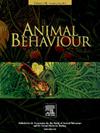Nest location and pheromone concentrations interact to influence female nest choice in sea lamprey
IF 2.3
2区 生物学
Q2 BEHAVIORAL SCIENCES
引用次数: 0
Abstract
Animal communication is dynamic; factors such as signal attributes, signaller and receiver positioning, and environment can interactively influence information exchange. However, most research has focused on the signals and preferences while neglecting the broader context in which they function. Using sea lamprey, Petromyzon marinus, we studied the effects of male signalling location on female nest choice. Male sea lamprey aggregate on spawning grounds in rivers where they build nests and release a sex pheromone to attract females. In controlled studies, females select nests with the highest relative concentration of pheromone, indicating some degree of mate choice following pheromone concentrations. In reality, however, the characteristics of pheromone signals detected by females (e.g. concentration) are shaped not only by the odour males emit but how they are transmitted downstream via river currents. We hypothesized that the effects of pheromone preferences on female nest choice also depend on the location of male nests. To test our hypothesis, we first surveyed the spatial distribution and use frequency of spawning nests in a wild population of sea lamprey. We then conducted instream behavioural assays using paired nest sites at two experimental locations and found that nest location and pheromone concentration impacted female nest choice. These behavioural results, along with indirect evidence for differences in pheromone plume dispersal at each site, suggest that signalling location and pheromone concentration may influence mate choice in sea lamprey. Although additional environmental factors likely influence natural mating decisions, our results highlight the importance of considering both signal attributes and the surrounding environment when studying communication networks.
巢的位置和信息素浓度相互作用影响雌七鳃鳗的巢选择
动物的交流是动态的;信号属性、信号发送者和接收者的定位以及环境等因素可以相互影响信息交换。然而,大多数研究都集中在信号和偏好上,而忽略了它们发挥作用的更广泛的背景。以海七鳃鳗(Petromyzon marinus)为研究对象,研究了雄性信号定位对雌性巢选择的影响。雄性海七鳃鳗聚集在河流的产卵地,在那里筑巢并释放性信息素来吸引雌性。在对照研究中,雌性会选择信息素相对浓度最高的巢穴,这表明信息素浓度对配偶的选择有一定程度的影响。然而,实际上,雌性检测到的信息素信号的特征(例如浓度)不仅取决于雄性发出的气味,还取决于它们如何通过河流向下游传播。我们假设信息素偏好对雌鸟巢选择的影响也取决于雄鸟巢的位置。为了验证我们的假设,我们首先调查了野生七鳃鳗种群中产卵巢的空间分布和使用频率。然后,我们对两个实验地点的成对巢穴进行了溪流行为分析,发现巢穴位置和信息素浓度影响了雌性的巢穴选择。这些行为结果,以及每个地点信息素羽扩散差异的间接证据表明,信号位置和信息素浓度可能影响海七鳃鳗的配偶选择。虽然其他环境因素可能会影响自然交配决定,但我们的研究结果强调了在研究通信网络时考虑信号属性和周围环境的重要性。
本文章由计算机程序翻译,如有差异,请以英文原文为准。
求助全文
约1分钟内获得全文
求助全文
来源期刊

Animal Behaviour
生物-动物学
CiteScore
4.60
自引率
8.00%
发文量
236
审稿时长
10.2 weeks
期刊介绍:
Growing interest in behavioural biology and the international reputation of Animal Behaviour prompted an expansion to monthly publication in 1989. Animal Behaviour continues to be the journal of choice for biologists, ethologists, psychologists, physiologists, and veterinarians with an interest in the subject.
 求助内容:
求助内容: 应助结果提醒方式:
应助结果提醒方式:


